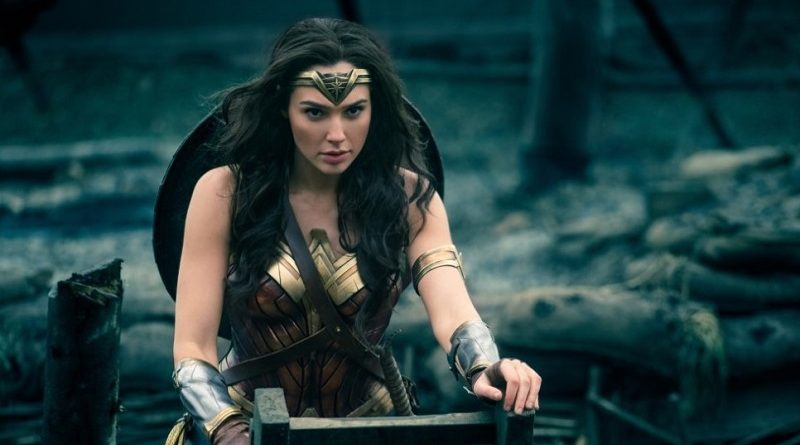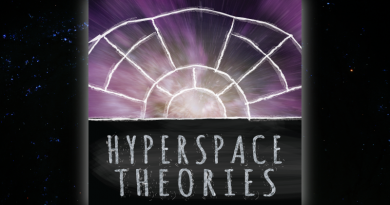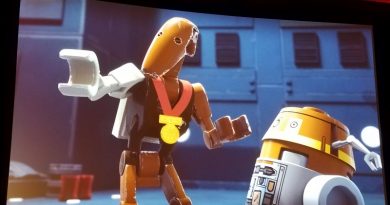The Heroine’s Journey in Wonder Woman (2017 film)
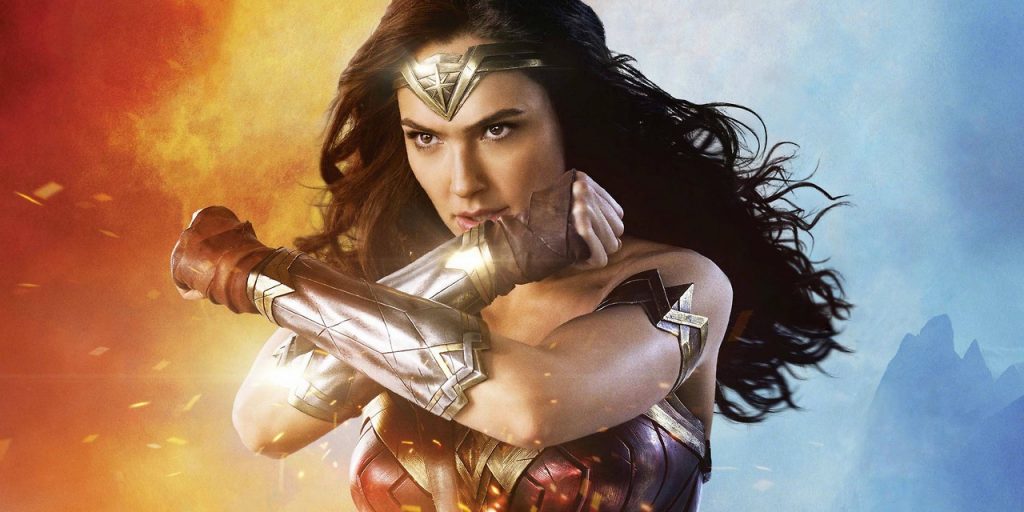 The Wonder Woman film is a great success by every measure: loved by fans, praised by critics, breaking records at the box office, inspiring a sense of optimism and heroism in challenging times, and more. Director Patty Jenkins, stars Gal Gadot and Chris Pine, and everyone who contributed to the movie’s triumph deserves the many accolades being bestowed upon them. Wonder Woman’s contribution to fandom, and society, will be long lasting.
The Wonder Woman film is a great success by every measure: loved by fans, praised by critics, breaking records at the box office, inspiring a sense of optimism and heroism in challenging times, and more. Director Patty Jenkins, stars Gal Gadot and Chris Pine, and everyone who contributed to the movie’s triumph deserves the many accolades being bestowed upon them. Wonder Woman’s contribution to fandom, and society, will be long lasting.
From the perspective of storytelling design, part of the film’s ability to resonate with so many people – not just women and girls, not only lifelong fans of the character – is found in the way Diana Prince’s cinematic origin story draws upon familiar frameworks and themes to pull the audience along with her on her adventure. The progress of the tale brings Diana through the stages of the Hero’s Journey, particularly the contemporary version described by Christopher Vogler. At the same time, the movie never loses sight of the fact that it is a female protagonist undertaking the journey, and gives the Amazon demigod a path of character development that also aligns with the Heroine’s Journey stages identified by Maureen Murdock. This, too, is likely to be a contribution of Wonder Woman that endures far beyond a summer blockbuster’s theatrical run.
Beginning the Adventure
With the literal mythology surrounding her origin, Diana’s tale lingers in her Ordinary World a bit longer than many films, which often spring the protagonist into the action after only a few minutes. To lay the groundwork for Diana’s fish-out-of-water experiences later, though, it is necessary to establish the contours of her upbringing on Themyscira. We see her first as a child, eager to become an Amazon warrior herself and entranced by the legends of the Greek gods and the weapons they bestowed upon the Amazons. As a teenager, her form of youthful rebellion is surreptitious combat training by her aunt Antiope despite the wishes of her mother, Queen Hippolyta. As a young woman she is powerful, nearly rivaling Antiope, though in her last training sequence she still is eager to please her mother and naïve in the unfairness of war.
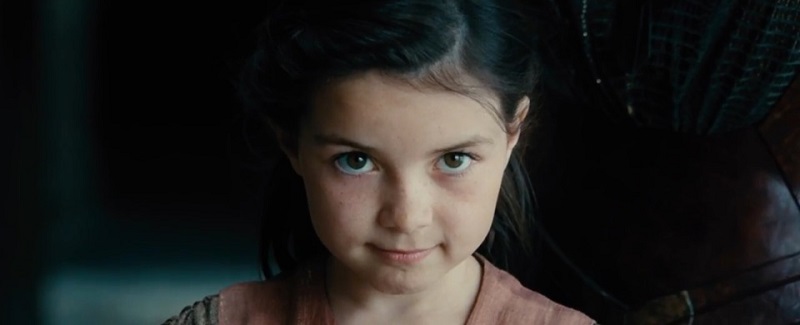 But Hippolyta’s concern for her daughter is no mere ordinary maternal protectiveness: she is well aware that the stronger Diana becomes, the sooner her foreordained antagonist, the god of war Ares, will find her. When the Call to Adventure arrives, it brings together Diana’s future and her past. Beaten down by powerful blows from Antiope’s sword, Diana crosses her arms and inadvertently ignites the true scope of her power in a blast wave that flattens the Amazons around her. That moment, too, brings Ares’ war to Themyscira. It arrives innocuously enough at first, with Steve Trevor’s stolen German warplane crashing into the sea. Diana does not hesitate to cliff-dive into the waters and save him. She does not fear the unknown, whether unfamiliar technology or her first encounter with a man.
But Hippolyta’s concern for her daughter is no mere ordinary maternal protectiveness: she is well aware that the stronger Diana becomes, the sooner her foreordained antagonist, the god of war Ares, will find her. When the Call to Adventure arrives, it brings together Diana’s future and her past. Beaten down by powerful blows from Antiope’s sword, Diana crosses her arms and inadvertently ignites the true scope of her power in a blast wave that flattens the Amazons around her. That moment, too, brings Ares’ war to Themyscira. It arrives innocuously enough at first, with Steve Trevor’s stolen German warplane crashing into the sea. Diana does not hesitate to cliff-dive into the waters and save him. She does not fear the unknown, whether unfamiliar technology or her first encounter with a man.
Established as yearning for a greater purpose, Diana does not experience a Refusal of the Call as stark as those of some other heroes, such as Luke Skywalker bemoaning his moisture farming obligations obstructing any prospect of leaving on a quest to help the Rebellion against the evil Empire. Still, the brusque appearance of reality does cause her at least some initial hesitation. Rather than embrace the power she unleashed, Diana apologizes to Antiope and hurries away from the training grounds. When the German soldiers storm the beach, Diana at first seeks cover behind the rocks with Steve and watches her Amazon peers fight the interlopers before emerging to join them and turn the tide. Upon hearing the truth of the War to End All Wars, Diana is fully convinced of the Amazons’ duty to enter the world of man to hunt down and defeat Ares. When her mother forbids their involvement in the war, Diana makes a literal leap of faith, trusting in her newfound powers to breach the imposing citadel and steal away iconic weapons and armor in the dead of night before heading toward the shore to sail away with Steve.
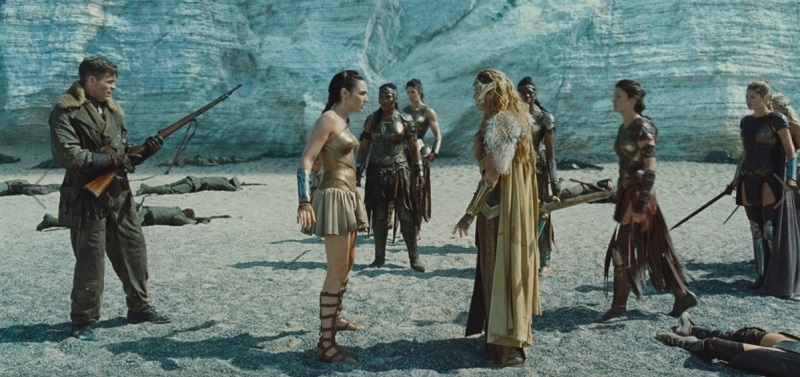 One important feature of the first act of the Hero’s Journey is Meeting the Mentor: the wise Ben Kenobi, the mysterious Gandalf, the curmudgeonly yet avuncular Haymitch Abernathy, and everything in between. In Wonder Woman, Diana does not have a traditional mentor in the sense of an elder advisor who joins her quest. Antiope provides Diana with combat training of unprecedented extent, and her death in the battle with the Germans helps cement Diana’s decision to start her adventure. The narrative role of companion mentor is instead fulfilled by Steve Trevor. On Themyscira, he shares the second-hand fatherly wisdom – you can either do nothing or do something – that helps inspire Diana to leave her home and fight. When they enter the world of men, Steve becomes her navigator through the unfamiliar realm, guiding her to learn the knowledge she needs to overcome her sheltered upbringing and confront the challenges of modernity and the World War. Near the film’s conclusion, he provides one final lesson about the world – it’s not about what people deserve, but what you believe – that guides Diana in making her final heroic choice in her showdown with Ares.
One important feature of the first act of the Hero’s Journey is Meeting the Mentor: the wise Ben Kenobi, the mysterious Gandalf, the curmudgeonly yet avuncular Haymitch Abernathy, and everything in between. In Wonder Woman, Diana does not have a traditional mentor in the sense of an elder advisor who joins her quest. Antiope provides Diana with combat training of unprecedented extent, and her death in the battle with the Germans helps cement Diana’s decision to start her adventure. The narrative role of companion mentor is instead fulfilled by Steve Trevor. On Themyscira, he shares the second-hand fatherly wisdom – you can either do nothing or do something – that helps inspire Diana to leave her home and fight. When they enter the world of men, Steve becomes her navigator through the unfamiliar realm, guiding her to learn the knowledge she needs to overcome her sheltered upbringing and confront the challenges of modernity and the World War. Near the film’s conclusion, he provides one final lesson about the world – it’s not about what people deserve, but what you believe – that guides Diana in making her final heroic choice in her showdown with Ares.
In some stories, Crossing the First Threshold is more metaphorical, as the hero leaves the ordinary world behind and enters the extraordinary world adventure. In Wonder Woman, the act is literal and visual – Diana and Steve pass through the invisible barrier surrounding mystical Themyscira into the gloomy nighttime of the real world. Following Hippolyta’s reminder that if she leaves she can never return, Diana’s act seals her decision to embark on her quest.
The two earliest stages of Murdock’s framework also appear clearly in the beginning to Diana’s Heroine’s Journey in Wonder Woman. The first is the Separation from the Feminine, which marks the break with her previous life necessary to propel the heroine through her path of personal growth. Diana’s farewell conversation with her mother – culminating in her rhetorical question, “who would I be if I stayed?” – precedes her departure from the island. Diana leaves the Amazons behind to enter a world dominated – unjustly, the movie repeatedly reminds us – by men.
Paired with this development is the second stage, Identification with the Masculine. Again, Diana’s choice is clearly signaled in the film: she teams up with Steve not simply to sail away from Themyscira, but to enter the world of man to seek out a war led and fought by men, in pursuit of her quest to defeat the male god of war. Both symbolically and in actuality, Diana has crossed into a completely different world than where her story began.
The Road of Trials
After entering the extraordinary world the protagonist must face repeated challenges, and learn from them, before being prepared to complete the heroic metamorphosis in the culmination of the adventure. Though Vogler and Murdock each denominate this as a single stage in the journey, it frequently comprises a significant section of the plot. For Diana in Wonder Woman, this is certainly the case.
Simply upon arriving in London, Diana encounters the Tests, Enemies, and Allies that Vogler expects in her journey. Steve introduces her to Etta Candy, who assists them several times in the mission ahead. Diana must change her attire to blend in among the metropolitan throngs, though she insists on maintaining her capacity to fight while wearing it – which she then promptly puts to use in dispatching the German goons. At the war council, Diana learns difficult truths about the leadership of the military Steve serves. Sir Patrick appears initially as an ally; only later does he reveal himself as the opposite.
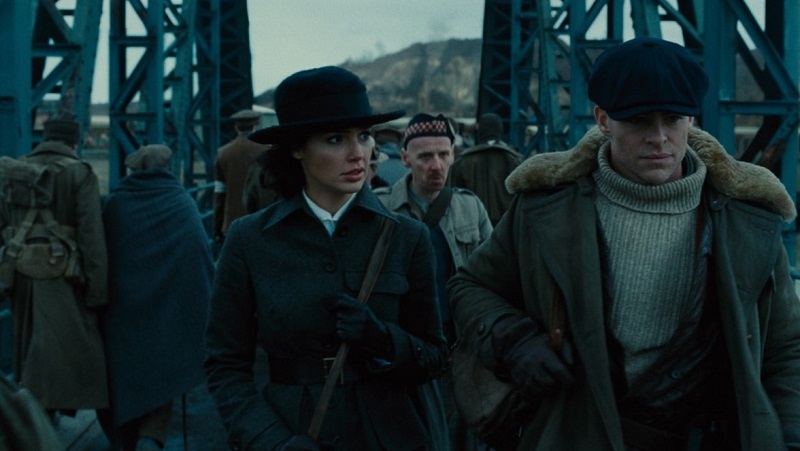 The flaws of his commanders do not stop Steve from doing the right thing, though, and it takes Diana a moment – and an amusing assist from the Lasso of Truth – to realize his values align with hers. Committed to their mission of stopping Ludendorff and Dr. Maru, they must devise a way to reach the front. Steve gathers a diverse team of allies: Samir, Charlie, and Chief, each of whom brings an important skill to the mission and represents a different form of oppression in the world of mankind. Diana soon witnesses the horrors of modern war: the grievously injured soldiers returning at the port, the hopeless battlefields of trench warfare, the refugees who have lost everything as innocent victims of international conflict. Steve and the others insist that they must ignore the suffering and push onward, but the obligation of commitment exclusively to a particular mission is one Diana refuses to accept.
The flaws of his commanders do not stop Steve from doing the right thing, though, and it takes Diana a moment – and an amusing assist from the Lasso of Truth – to realize his values align with hers. Committed to their mission of stopping Ludendorff and Dr. Maru, they must devise a way to reach the front. Steve gathers a diverse team of allies: Samir, Charlie, and Chief, each of whom brings an important skill to the mission and represents a different form of oppression in the world of mankind. Diana soon witnesses the horrors of modern war: the grievously injured soldiers returning at the port, the hopeless battlefields of trench warfare, the refugees who have lost everything as innocent victims of international conflict. Steve and the others insist that they must ignore the suffering and push onward, but the obligation of commitment exclusively to a particular mission is one Diana refuses to accept.
Many reviewers, critics, and fans have commented on the power of the No Man’s Land sequence in the film, both visually and thematically. In Diana’s heroic journey, it is a test of her values as a heroine. She could, like Steve, put her head down and ignore everything except the necessities of the specific goal. But she cannot. Diana has the values of an Amazon warrior: raised to believe in justice, trained to fight for it, and dedicated to the sacrifice she made in leaving her home forever to bring peace to the world of man. She doffs the concealing clothing from London and emerges on the battlefield in full mythical regalia. She leads the charge across the uncrossable terrain, drawing fire and achieving the impossible. With her team behind her, she liberates the village of Veld and, at least briefly, brings a respite from the war to its traumatized residents.
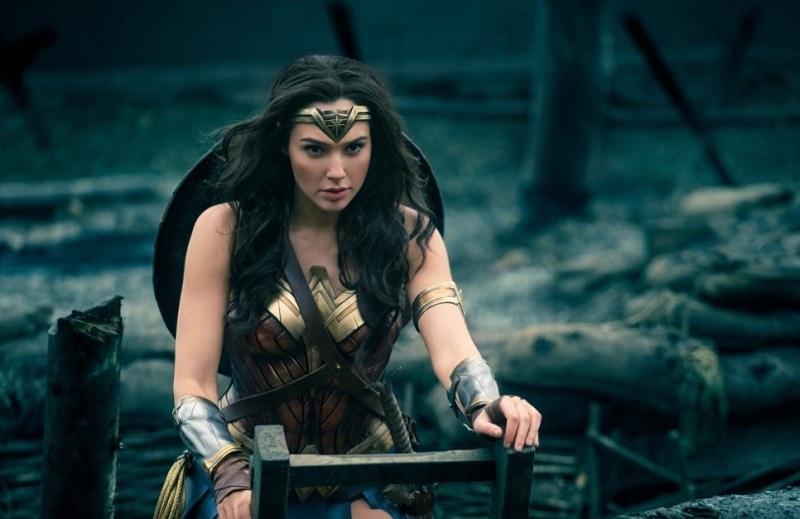 Diana, too, earns a brief reward for her first heroic accomplishment in the world of man. The photo of her victory, the token from Bruce Wayne that bookends the film, is taken. Music, drink, and dancing return. Diana and Steve spend the night together. Unlike many tellings of the Hero’s Journey, however, the presence of a love interest is not a distraction that threatens to divert the hero from continuing with the quest. Steve is committed to fighting the war, too, and theirs is a romance kindled by the war, not in avoidance of it.
Diana, too, earns a brief reward for her first heroic accomplishment in the world of man. The photo of her victory, the token from Bruce Wayne that bookends the film, is taken. Music, drink, and dancing return. Diana and Steve spend the night together. Unlike many tellings of the Hero’s Journey, however, the presence of a love interest is not a distraction that threatens to divert the hero from continuing with the quest. Steve is committed to fighting the war, too, and theirs is a romance kindled by the war, not in avoidance of it.
Of course, passing one test only brings on further difficulties for the heroine. In the morning Steve and Diana quickly end up at odds over mission priorities, with Steve focused on finding and destroying the chemical weapons facility while Diana is concerned only with finding and defeating Ares. At the fortress, she ignores his admonition to stay behind, obtains a dress, and sneaks into the German gala. She has a face-to-face confrontation with Ludendorff, the man she believes to be her nemesis, and only Steve’s intervention stops her from killing him amid the crowded dancehall. Moments later Diana faces the futility of war, when Ludendorff’s cannons fire the gas that kills everyone in Veld. Believing the general’s death would have stopped the war, she blames Steve for the massacre and leaves to hunt down Ares without him.
The Final Showdown
In studying or telling stories with the Hero’s Journey or Heroine’s Journey framework, it is important to remember that the stages of the journey describe the character development progression of the protagonist, not the segmenting of the plot. Whether Campbell, Murdock, or Vogler, the plot may linger on one stage – often, as with Wonder Woman, in the Road of Trials – and then race through multiple stages in a handful of scenes. Especially in cinematic tales drawing heavily from Vogler, many of the later stages of the framework may transpire in only a few minutes of screen time. Patty Jenkins achieves this masterfully in Wonder Woman, bringing Diana’s heroic arc to its culmination in a series of swift and effective scenes.
In Vogler’s model of the Hero’s Journey, Approaching the Inmost Cave occurs when Diana reaches the German airbase, which is both the heart of the enemy’s war operations as well as the site of her intended confrontation with her nemesis. Her Ordeal and Reward come quickly: she finds Ludendorff in the observation tower, fights him, and kills him with the Amazon sword. While the hero has achieved a victory, though, Vogler emphasizes that in cinematic journeys a worse and more deadly challenge is usually imminent.
 The Road Back challenges Diana’s emotional progression as much as her combat prowess. Only moments after Ludendorff’s death, she realizes that the war has not ended. Humanity is not suddenly released from the thrall of an evil god. Steve admits that truth to her: not all people are good, or want to do good. Their conversation mirrors Diana’s departure from Themyscira, with Steve the one who needs to leave to fight and Diana the one who deems mankind unworthy of Amazon aid. With Steve gone and Diana severed from her beliefs in the goodness of man, Ares reveals himself. As villains are wont to do, he tells her not lies but the truth, about his past and her true nature. Ares offers a vision of what he seeks to accomplish with her help – and despite her agony at mankind, Diana rejects it. She still desires to fulfill her preordained quest to defeat the god of war. When Ares destroys the Amazon sword, Diana does not falter. She opens herself to her superhuman powers, beginning to fight Ares on different terms. After a momentary farewell with Steve, she watches his death as the bomber explodes.
The Road Back challenges Diana’s emotional progression as much as her combat prowess. Only moments after Ludendorff’s death, she realizes that the war has not ended. Humanity is not suddenly released from the thrall of an evil god. Steve admits that truth to her: not all people are good, or want to do good. Their conversation mirrors Diana’s departure from Themyscira, with Steve the one who needs to leave to fight and Diana the one who deems mankind unworthy of Amazon aid. With Steve gone and Diana severed from her beliefs in the goodness of man, Ares reveals himself. As villains are wont to do, he tells her not lies but the truth, about his past and her true nature. Ares offers a vision of what he seeks to accomplish with her help – and despite her agony at mankind, Diana rejects it. She still desires to fulfill her preordained quest to defeat the god of war. When Ares destroys the Amazon sword, Diana does not falter. She opens herself to her superhuman powers, beginning to fight Ares on different terms. After a momentary farewell with Steve, she watches his death as the bomber explodes.
Her grief-fueled rage unleashed, Diana strikes down German soldiers with impunity before Ares offers her the opportunity to destroy Dr. Maru as well. In that moment, though, she reconnects with her memory of Steve and makes a decision about what she is truly fighting for. This is her Resurrection, the Climax of her journey in which she accepts her role as the Godkiller. She turns Ares’ power back upon him, fulfilling her quest. The film then returns to the present day, Diana lingering over the century-old photograph. Her quest was not one to obtain a magical weapon, but to become one. Her Return with the Elixir is her ongoing commitment to the choice she made at the airbase: to fight for justice, but always to remember that “only love can save the world.”
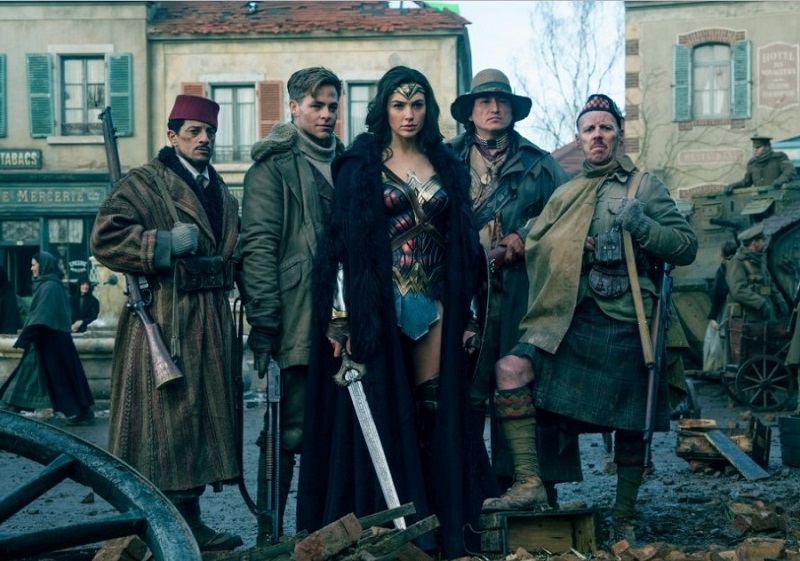 These same events and choices in Diana’s story also align with Murdock’s stages for the Heroine’s Journey. When Diana kills Ludendorff, she believes she has accomplished her goal in the world of man. In fact, though, that moment is her Illusory Boon of Success. The war is not over; mankind, not Ares, is the problem. A seeming triumph on the terms of the world of man cannot be her true victory. The argument with Steve atop the observation tower represents Diana’s confrontation with feelings of Spiritual Aridity. Her deepest beliefs about the world have been shattered. She doubts whether mankind is even worth protecting. Perhaps she left Themyscira behind for nothing.
These same events and choices in Diana’s story also align with Murdock’s stages for the Heroine’s Journey. When Diana kills Ludendorff, she believes she has accomplished her goal in the world of man. In fact, though, that moment is her Illusory Boon of Success. The war is not over; mankind, not Ares, is the problem. A seeming triumph on the terms of the world of man cannot be her true victory. The argument with Steve atop the observation tower represents Diana’s confrontation with feelings of Spiritual Aridity. Her deepest beliefs about the world have been shattered. She doubts whether mankind is even worth protecting. Perhaps she left Themyscira behind for nothing.
The arrival of Ares cuts short Diana’s chance to reconsider her purpose. By revealing that Diana is a demigod, herself also a child of Zeus, he triggers her Initiation and Descent to the Goddess. Realizing the truth for what it is, Diana accepts her true nature and begins to openly wield supernatural powers far beyond simply superhuman speed or strength. The fight with Ares also instigates her in Reconnecting with the Feminine: she declares that she fights not simply as herself, but as the daughter of Hippolyta and the bringer of the Amazon’s destiny for the world.
Accepting the truth that she, not the sword, is the Godkiller weapon gives Diana the fortitude to make the choices that bring her victory. Hippolyta always had feared the day this showdown would come, but Diana is capable of Healing the Mother/Daughter Split. She is courageous and unafraid as she fights Ares with nothing less than the fate of the world in the balance. Her victory, though, comes not only from her mother, but also by Healing the Wounded Masculine: her farewell with Steve, his expression of love and passing on the watch as a token of remembrance, gives her the strength to recognize what is worth fighting for. Mankind is deeply flawed, and injustice and war will never be erased from the world, but love is what makes living worthwhile. In making this choice, Diana moves Beyond Duality, an act of Healing the Feminine/Masculine Split, to complete her arc through the Heroine’s Journey. Yes, she will fight – but she fights for love, not only love of Steve Trevor but of the possibility in all mankind. The epilogue in the present day shows that Diana remains committed to this principle a century later, heroically fighting for justice while motivated by love.
Wonder. Confidence. Power. Courage. Grace. Wisdom. Such simple words, really, but few truly embody all that they stand for. And then there is Wonder Woman, one of the most enduring and beloved Super Heroes of all, who is all of those things and more. She inspires hope and love at the same time she fights evil and hatred; she helps bring good into the world, transcending eras or historical events. She is a rare creation, a forever character. As a filmmaker and a fan, I am drawn to classic storytelling, but as a woman, to discover such a complex and compelling woman at the helm of a universal hero’s journey? What a wonderful gift.
~ Patty Jenkins, foreword (page 6), in Wonder Woman: The Art and Making of the Film
Wonder Woman reaffirms that female characters can have stories that echo the tried and true monomyth first described by Joseph Campbell. The adherence to the familiar structure enables anyone, regardless of gender, to engage with the titular hero. But Diana Prince’s story is not only filmed from the female gaze, but also told through the lens of a female-centric model of heroism. It reflects the struggles of women to live in a world defined by the myths of men and yet chart a course that exemplifies their experiences and values. Like Diana herself, Wonder Woman synthesizes the Hero’s Journey and the Heroine’s Journey as a role model for all of us.
Related links:
- BJ Priester Talks The Acolyte Episode 6 on Who’s the Bossk? - July 7, 2024
- Dave Filoni Talks Writing AHSOKA and Guiding the Future of Star Wars Storytelling - June 21, 2024
- Lessons in Franchise Management – MCU: The Reign of Marvel Studios - January 14, 2024

